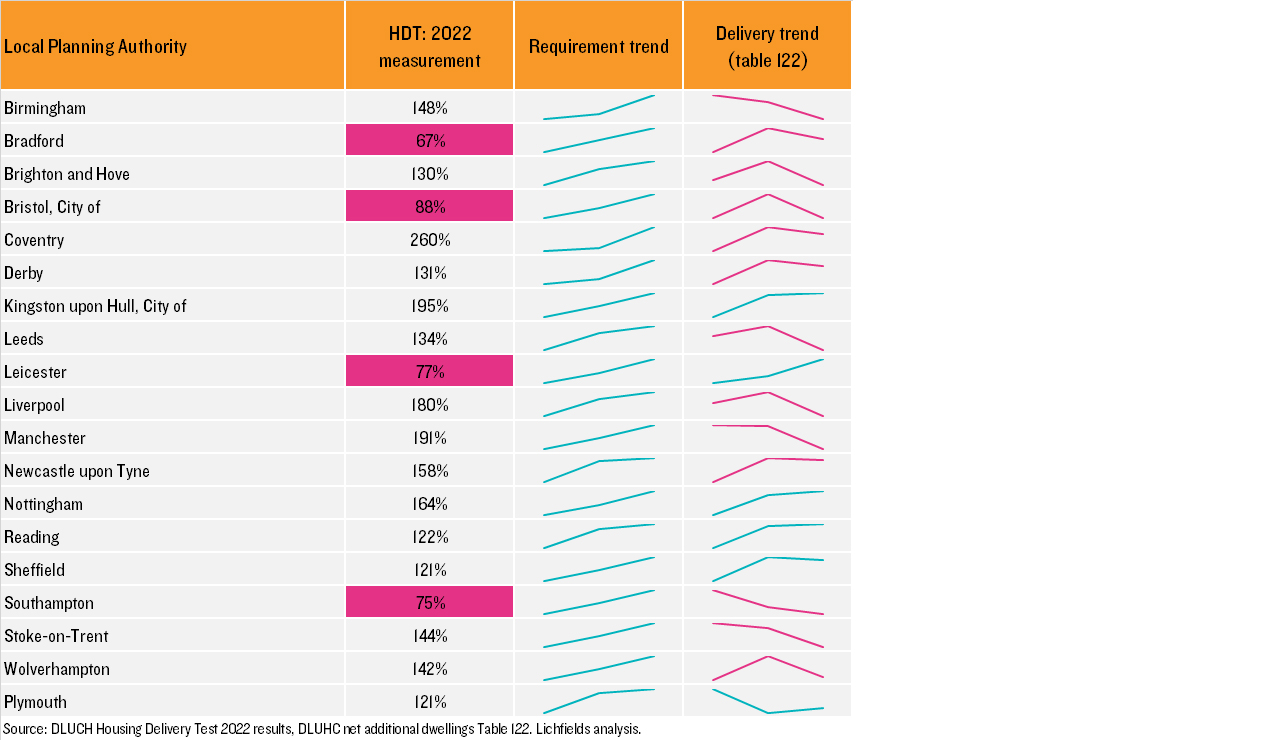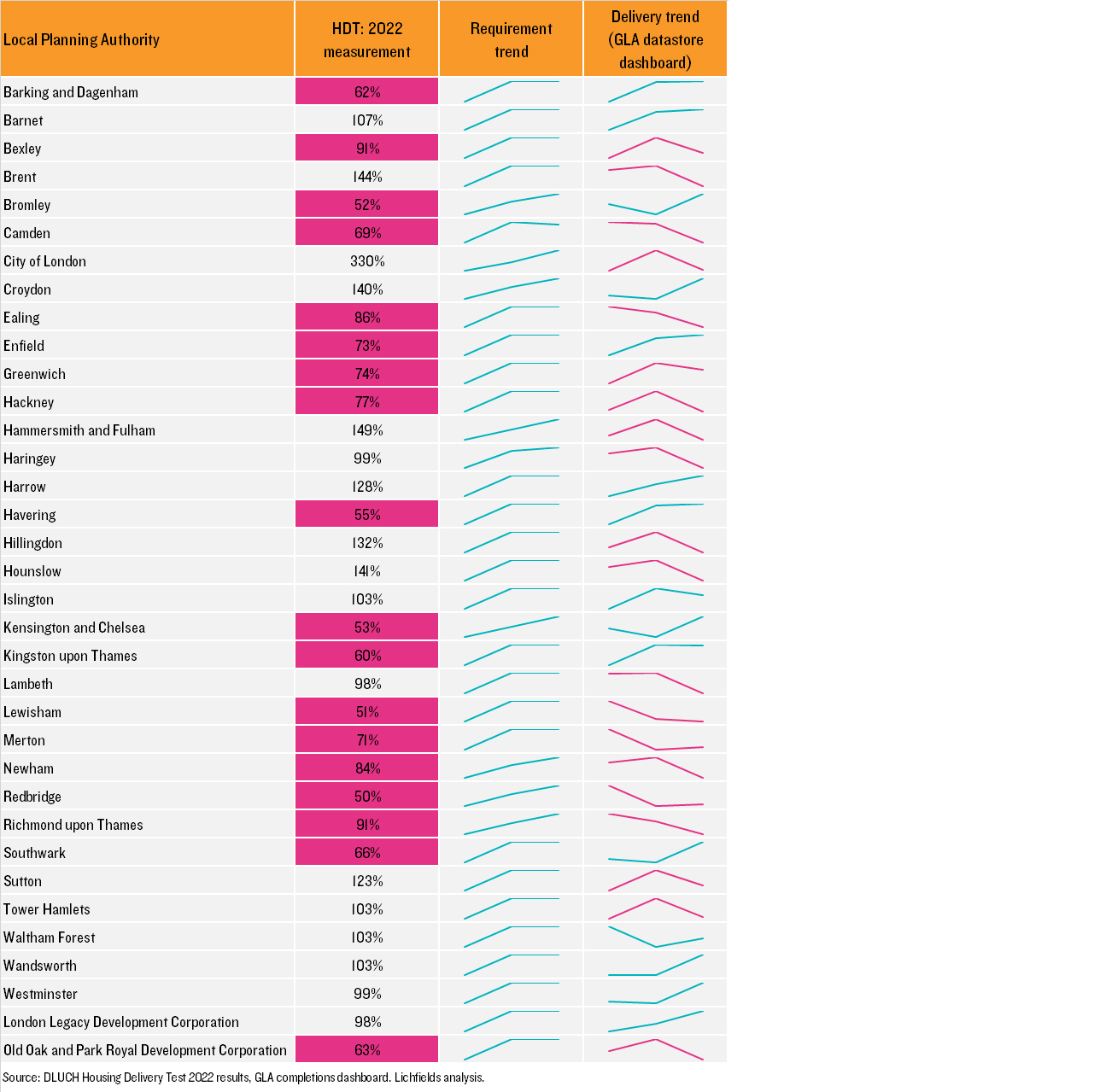Among a flurry of planning updates on 19 December 2023, the Secretary of State (SoS) announced the appointment of an expert panel to carry out a review of the London Plan
[i].
That Panel, chaired by Christopher Katkowski KC and comprising Cllr James Jamieson, Dr Paul Monaghan and Dr Wei Yang, was tasked with assessing whether specific changes could be made to London Plan policies that could facilitate urban brownfield regeneration for housing delivery. Lichfields was pleased to be appointed by DLUHC to provide support to the Panel in preparing the report, which was duly delivered on 15
th January 2024
[ii].
Today, the
Panel’s findings were published alongside a suite of housing-related announcements from the Secretary of State. The Government's proposed response to the LPR recommendations extend beyond the housing problems of the ‘The Great Wen’.
The London Plan Review (‘LPR’)
The LPR explores housing delivery in the capital across a range of metrics, particularly in looking at change in trends since the London Plan was introduced. The starting point is an acknowledgement that there is a crisis of housing under-supply in London. The London Plan had been formulated based on an evidence base that concluded there was sufficient land to provide 52,300 homes a year between 2019/20 and 2028/29 with a strategy for ‘good growth’ that was considered by the Inspectors as “aspirational but realistic”. This target was below the assessment of need that was undertaken in the preparation of the London Plan, which identified a need of around 66,000 homes per annum.
Based on a consideration of the evidence – including insights from both public and private sector stakeholders - the LPR recognises that there is no one cause of housing under-delivery in London: the effects of wider macro-economic conditions; fire safety; infrastructure constraints; statutory consultees; viability difficulties and planning resourcing pressures have all contributed to the under-delivery of housing against London Plan targets.
Nevertheless, the under-delivery to date is significant:
-
Four years into the London Plan’s ten-year housing target period, when measured against the cumulative target, there has been an undersupply of more than 60,000 homes;
-
To make good this backlog, the rate of delivery forthwith would need to increase from 52,300 to more than 62,300 homes a year;
-
There has been downward trend in housebuilding which, if it continues, would result in a shortfall of more than 150,000 homes – equivalent to 29% of the total target – by 2028/29;
-
There has been a reduction in the number of residential units being permitted, with GLA data showing a reduction from over 89,000 in 2018/19 to 68,000 in 2021/22 and this is now down to 40,200 in 2022/23. A shrinking flow of planning permissions will reduce the overall pipeline that can be built-out in future years.
In addition to the factors identified above, the LPR report says the Panel found persuasive evidence that the combined effect of the multiplicity of policies in the London Plan “now works to frustrate rather than facilitate the delivery of new homes on brownfield sites, not least in creating very real challenges to the viability of schemes”.
The report (paras 4.6-4.7) says:
“The London Plan weighs in at over 500 pages and contains 113 policies, all of which include several elements. The Plan contains literally hundreds of requirements, exhortations and aspirations and, depending on the circumstances of an individual application, a great many of these bear upon deciding whether to permit residential development on brownfield sites.
A proposal to build new homes on what might be thought to be a relatively straightforward case of a brownfield site which is not in or affected by any form of special protection (e.g. heritage) will have to navigate and negotiate its way through elements of at least 45 policies.”
The Panel heard from the GLA that policy goals in the Plan are being incorrectly applied mechanistically as absolute requirements: as ‘musts’ rather than ‘shoulds’
[iii], a view which informed the GLA’s clarification on its Housing Design Standards LPG that its guidance
“should not be applied mechanistically. The weight to attach to any departure from standards is ultimately a matter for the decision maker”[iv].
Ultimately, the Panel found that "there is so much to navigate and negotiate in the London Plan", that "wending one’s way through the application process is expensive and time-consuming". The LPR concludes:
“Without a step change, it is highly unlikely that the housing targets of the London Plan will be met within its ten-year period and, as a consequence, the current housing crisis will continue, if not worsen.”
The Panel’s recommendations
In light of the downward trend for housing delivery in London, the Panel was set the task of considering potential changes that could be made to the London Plan. It identified three main options. The first two were: 1) awaiting the next review of the London Plan to enable a comprehensive approach to be taken, or 2) making specific alterations to the individual policy requirements which are most often cited by commentators as inhibiting the timely delivery of new homes. Both options were discounted for reasons set out in the report, including the disbenefit of waiting for the next review of the London Plan, and the complex and inter-linking nature of reviewing individual policy requirements outwith a formal plan review process.
It settled on a singular recommendation: “the introduction of an overarching policy, which would bring together all the relevant issues in any given case of an application for residential development on a brownfield site and provide a lens through which to focus on how to resolve what will often be a myriad of competing considerations pulling in different directions.”
The wording of the presumption – expressed in similar terms to the ‘tilted balance’ in the NPPF but with some distinct elements
[v] – would apply to the grant of planning permission for proposals comprising residential development on brownfield land. It would exclude sites in the Green Belt or Metropolitan Open Land, or Strategic Industrial Locations, or where it would cause harm to the significance of a designated heritage asset which is not clearly outweighed by the public benefits.
The Panel recommended the presumption should apply in local planning authorities that had under-delivered against the cumulative total of their ten-year targets (in order to recognise and incentivise delivery), but an option was also presented should the Secretary of State conclude that it should apply across London. The recommended approach of measuring the cumulative number of net completions against the ten-year target would mean - based on current data - that the presumption would have applied to all but four London boroughs.
In line with the terms of reference, the presumption was proposed as a policy for direct insertion into the London Plan
[vi] but with the complementary suggestion that its wording be introduced as a Written Ministerial Statement and/or in the Planning Practice Guidance.
Proposed implementation of its recommendations
Having considered the report and its recommendations, the Secretary of State has proposed that the concept of a brownfield residential presumption in areas of housing under-delivery, as put forward by the Panel, should be considered for insertion into the NPPF as part of the paragraph 11 presumption, rather than being limited to London. That addition to the Framework will require a further consultation, which begins today and will
close on the 26 March 2024.
The scope of the consultation considers two proposals which have been informed by the LPR:
-
A change to national planning policy that would expect local planning authorities to give significant weight to the benefits of delivering as many homes as possible, and to be flexible in applying policies or guidance on the internal layout of developments especially for proposals on brownfield land. This policy would apply to all authorities and is proposed through an amendment to paragraph 129c).
-
The application of the presumption in favour of sustainable development in respect of previously developed land only for those 20 towns and cities subject to the urban uplift, where their Housing Delivery Test score falls to 95% or below. This is proposed through an addition to footnote 8 of the Framework and the circumstances in which the Framework presumption applies.
Proposal 1
For the first proposal, the consultation document is clear in setting out that the proposed amendment “does not remove legal requirements nor the importance of other considerations relating to beauty or undermine wider considerations of character as part of the plan-making process”.
Rather, the approach proposed is intended to help guide decision-makers in the weight to be attributed to the benefits of delivering as many homes as possible. It expands on the existing approach to daylight and sunlight which is set out in the NPPF, to now encompass internal layouts. The application of this expanded approach will still be dependent on site-specific considerations and a balancing assessment by a decision-maker when assessing the extent to which proposed development on previously developed land does not comply with relevant policies or guidance.
Proposal 2
The approach proposed applies an expanded policy presumption for previously developed land to England’s 20 most populous towns and cities
[vii], given the importance of delivering housing in these areas.
The consultation explains that, if implemented, the policy would align with the publication of the HDT 2023 results. Because these have not yet been published, it is not possible to indicate precisely where this presumption would apply. When measured against the 2022 HDT results, 18 London boroughs/Development Corporations and just four of the other 19 uplift areas would have the presumption applied. As the existing presumption already applies where an authority’s HDT result is less than 75%, in London the proposal would apply the presumption to an additional five boroughs beyond the existing HDT consequences, and in the other 19 uplift areas it would apply to three additional authorities
[viii].
What is the likely consequence for the 2023 HDT results? We have reviewed the data for the anticipated HDT housing requirements for 2023
[ix], and measures of the net additional homes delivered over the past three years, as an interim proxy.
The analysis in the following tables shows that the ‘housing requirement’ element of the 2023 HDT calculation will increase in most places. This is because the 35% uplift factor in the Standard Method (introduced in December 2020 and applying in the 2022 HDT to just 2021/22) will also apply to 2022/23
[x]. In addition, the reduced-requirement mitigation for the effects of the pandemic in 2019/20 falls away.
Meanwhile, the housing delivery trend, measured by the GLA completions dashboard and DLUHC Table 122, indicates a significant proportion of authorities are experiencing a general downward trend in their housing delivery over the past three-year period.
When these two factors are combined, it seems inevitable that the proposed new presumption will apply to many more authorities in the 2023 HDT, but the precise extent of this will only be known when those results are published.
The consultation questions posed also give scope for potential further expansion of the presumption. Two of the main questions for consideration are 1) whether the threshold of 95% is appropriate, and 2) whether it should only apply to authorities that are already subject to the urban uplift. While the potential implications of these options will need further analysis (together with the 2023 HDT test results), it does raise the question of how equivalent policy support in other urban areas – outside of the top 20 (for example, those towns and cities in the OxCam Arc, or urban authorities within City Regions e.g. in Greater Manchester, West Yorkshire, West Midlands, Liverpool or Tyneside) – might further increase the delivery of housing on brownfield sites.


[i] Accompanied by a rather direct letter to the Mayor which included the line: “If you cannot do what is needed to deliver the homes that London needs, I will” – see here
[ii] Something which was considered news in of itself – see here
[iii] Fun fact: in the London Plan the word ‘must’ appears 161 times cf 1,540 times for the word ‘should’.
[iv] The Housing Design Standards LPG can be found here
[v] The reference to granting permission “as quickly as possible” and making clear that in applying the presumption “substantial weight is to be given to the benefits of delivering homes."
[vi] The Secretary of State has (so far unused) powers (under section 340 and 341 of the Greater London Authority Act 1999) to formally direct the Mayor and instruct changes to the London Plan.
[vii] These 20 being those to which the 35% uplift to the Standard Method applies. These 20 places are defined by their population rather than by name – see our blog here. A feature of this approach is that the presumption would apply in Manchester but not Salford; in Birmingham but not any of the Black Country; and in Newcastle, but not Gateshead.
[viii] Currently, the HDT presumption consequence only applies when housing delivery is at <75%.
[ix] For the purposes of identifying trends in lieu of the 2023 HDT results, these requirements have been calculated based on the current local plan position and has not apportioned requirements where the plan status changed through the assessment period.
[x] In those locations where the housing requirement is not set in an up-to-date adopted local plan. Sadly, this is most places.





